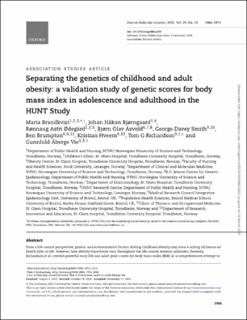| dc.contributor.author | Brandkvist, Maria Charlotta | |
| dc.contributor.author | Bjørngaard, Johan Håkon | |
| dc.contributor.author | Ødegård, Rønnaug | |
| dc.contributor.author | Åsvold, Bjørn Olav | |
| dc.contributor.author | Smith, George Davey | |
| dc.contributor.author | Brumpton, Ben Michael | |
| dc.contributor.author | Hveem, Kristian | |
| dc.contributor.author | Richardson, Tom G. | |
| dc.contributor.author | Vie, Gunnhild Åberge | |
| dc.date.accessioned | 2021-03-08T12:51:54Z | |
| dc.date.available | 2021-03-08T12:51:54Z | |
| dc.date.created | 2021-01-18T20:59:01Z | |
| dc.date.issued | 2020 | |
| dc.identifier.issn | 0964-6906 | |
| dc.identifier.uri | https://hdl.handle.net/11250/2732186 | |
| dc.description.abstract | From a life-course perspective, genetic and environmental factors driving childhood obesity may have a lasting inf luence on health later in life. However, how obesity trajectories vary throughout the life-course remains unknown. Recently, Richardson et al. created powerful early life and adult gene scores for body mass index (BMI) in a comprehensive attempt to Downloaded from https://academic.oup.com/hmg/article/29/24/3966/6020202 by guest on 05 March 2021 Human Molecular Genetics, 2020, Vol. 29, No. 24 3967 separate childhood and adult obesity. The childhood score was derived using questionnaire-based data administered to adults aged 40–69 regarding their relative body size at age 10, making it prone to recall and misclassification bias. We therefore attempted to validate the childhood and adult scores using measured BMI data in adolescence and adulthood among 66 963 individuals from the HUNT Study in Norway from 1963 to 2019. The predictive performance of the childhood score was better in adolescence and early adulthood, whereas the predictive performance of the adult score was better in adulthood. In the age group 12–15.9 years, the variance explained by the childhood polygenic risk score (PRS) was 6.7% versus 2.4% for the adult PRS. In the age group 24–29.9 years, the variance explained by the adult PRS was 3.9% versus 3.6% for the childhood PRS. Our findings support that genetic factors driving BMI differ at young age and in adulthood. Within the framework of multivariable Mendelian randomization, the validated childhood gene score can now be used to determine the consequence of childhood obesity on later disease. | en_US |
| dc.language.iso | eng | en_US |
| dc.publisher | Oxford University Press | en_US |
| dc.relation.uri | https://watermark.silverchair.com/ddaa256.pdf?token=AQECAHi208BE49Ooan9kkhW_Ercy7Dm3ZL_9Cf3qfKAc485ysgAAArIwggKuBgkqhkiG9w0BBwagggKfMIICmwIBADCCApQGCSqGSIb3DQEHATAeBglghkgBZQMEAS4wEQQMdEwGDOYM6pDtGH-J | |
| dc.rights | Navngivelse-Ikkekommersiell 4.0 Internasjonal | * |
| dc.rights.uri | http://creativecommons.org/licenses/by-nc/4.0/deed.no | * |
| dc.title | Separating the genetics of childhood and adult obesity: a validation study of genetic scores for body mass index in adolescence and adulthood in the HUNT Study | en_US |
| dc.type | Peer reviewed | en_US |
| dc.type | Journal article | en_US |
| dc.description.version | publishedVersion | en_US |
| dc.source.journal | Human Molecular Genetics | en_US |
| dc.identifier.doi | 10.1093/hmg/ddaa256 | |
| dc.identifier.cristin | 1873720 | |
| dc.relation.project | Norges forskningsråd: 295989 | en_US |
| dc.relation.project | Norges forskningsråd: 250335 | en_US |
| dc.description.localcode | © The Author(s) 2020. Published by Oxford University Press. All rights reserved. For Permissions, please email: journals.permissions@oup.com This is an Open Access article distributed under the terms of the Creative Commons Attribution Non-Commercial License (http://creativecommons.org/ licenses/by-nc/4.0/), which permits non-commercial re-use, distribution, and reproduction in any medium, provided the original work is properly cited. | en_US |
| cristin.ispublished | true | |
| cristin.fulltext | original | |
| cristin.qualitycode | 2 | |

